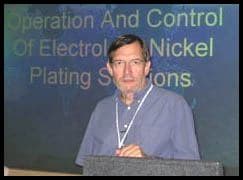
-----
Best activation for EN plating of a complex shape 400 SS part
We need to EN plate a plastic injection mold for an auto lamp. The mold is made of a 400 series stainless steel known as CSM-21 and then has to be mirror polished. The geometry is complex and adhesion has to be absolutely assured. The ASM Metals Handbook mentions an alternative preparation for complex shaped parts made of 400 series SS which we've never tried that involves a double immersion in HCl at different temp and conc. with a rinse in between. I assume this is due to a poor throwing power of the Woods bath. The question is: In your experience is this HCl immersion method safe enough (equivalent to Woods), would it be preferable to make the Woods plate into recesses (using conforming anodes, modifying it) or is there another pretreatment out there that is better?
Guillermo MarrufoMonterrey, NL, Mexico
2003
2003
I have used the hot HCl activation in the past when it was impossible to Woods strike. The resulting adhesion was marginal. I would recommend a Woods strike if at all possible.

Ron Duncan [deceased]
- LaVergne, Tennessee
It is our sad duty to note Ron's passing on Dec. 15, 2006. A brief obituary opens Episode 13 of our Podcast.
2004
Ron:
I appreciate this follow up specially more coming from you, one of the authors of the cited article. Unfortunately, the answer came a little late. We went with your immersion alternative but adhesion was indeed almost zero. Fortunately, we could strip the whole mold by pulling the EN plate with vinyl tape, thus avoiding striping chemicals and damage to the highly polished surface. We then filled a large new tank with 1/3 diluted Woods, and used very low current density (1 A/sq.dm) for an extended 10 fold period. The mold plated well except for some little recessed areas. I think the problem can be overcome with sufficient dummying of the W bath which we couldn't do due to the extreme urgency the customer had, as well as other inconveniences of working on these holidays. This weekend we will come down to the customer plant and try to repair these areas with an acid brush plating nickel.
Please feel free to follow up again at your convenience regarding any experience with dilution or modification of the Woods technique or any other alternatives for complex shaped SS parts.
Best regards,
Guillermo MarrufoMonterrey, NL, Mexico
I plate EN on polished 400 series mold tools this way:
-Periodic Reverse Clean -15% H2SO4
-Wood's,50ASF
-EN
I keep the rinsing to a minimum (30 sec).
Kevin KeatingPlating - New York
2004
Q, A, or Comment on THIS thread -or- Start a NEW Thread